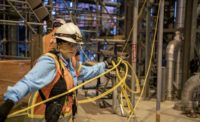Eric Schmieman traces the project's development—and cost escalations—back to 2001, when he joined the Bechtel-led project management unit. "Conceptual design is really a risk-management effort," he says. For the Chernobyl project, he says, "the level of design development varied widely and directly in proportion to the uniqueness of the design. Nobody had built an arch like this before or slid anything like it in place." Traditional elements such as cladding, internal cranes and ventilation systems waited their turn, and their estimated costs formed part of the provisional sum.
As Novarka got deeper into the design, elements covered by estimated sums turned out to be more complicated than first thought. For example, the fairly simple initial cladding design, covered with aluminium sheets, evolved into a more sophisticated solution using a stainless-steel covering, says Schmieman.
Using a fast-track approach, Novarka began arch construction in April 2012, says Novak. Under a subcontract, Cimolai S.p.A., Pordenone, Italy, fabricates and test-assembles the vault's tube steel sections in Italy. After dismantling the test modules, Cimolai sends steel-tube sections to a receiving area next to the Chernobyl site. From there, the steel sections are sent to the nearby assembly area to form the arch.
The site team first assembles and clads the arch's central section with 1,000-tonne-capacity jacking towers spaced along both edges. It then assembles more arch steelwork on either side of the central section, attached to it through hinges at the jacking towers. The towers are then moved outward, so the edges of the arch steelwork can be similarly attached to the already assembled section. The towers then lift the completed structure to its final height. After lifting the clad and partially equipped structure, crews recently slid the first half of the arch out of the way.
Novak expects the vault's second half to be fully assembled by the end of this year. Both halves are due to be joined sometime in mid-2016, and Novak expects the whole assembly will be slid over the reactor building in spring 2017.
Against the backdrop of the complex work, the Chernobyl environment adds new dangers. Footpaths and office areas around the plant are now relatively uncontaminated, but soil and vegetation remain potentially hazardous, says Schmieman. Positioned close to the reactor building, a worker would receive a year's allowed radiation exposure in around 10 days, he adds. Since the disaster, the 30-kilometer exclusion zone has remained in place.
Some 20 project-management unit staff and about 200 contractors and supervisors live some 70 km from the site, a 40-minute train ride through the contaminated forest at Slavutich, a 25,000-person, Soviet-era town constructed since the disaster. Site workers live some 10 km from the plant at the preexisting Chernobyl village, which have been made safe for occupation. Some 600 workers alternate 15-day shifts, allowing visits to their far-flung homes.
To minimize their exposure to radiation, workers cleared the steelwork assembly area of debris and vegetation, covered it with clean fill and sealed it with reinforced concrete. With a radiation dose rate of 0.01 mSv/hr, it would take 2,000 hours for a worker to reach the annual exposure limit, according to official data.
Novak claims the site has, so far, a "fantastic" health and safety record on par with "best international practice."
While Novarka's new contracts have yet to be finalized, nearby political troubles—such as the collapse of the government and Russia's annexation of Ukraine's Crimea—are creating unease, though they have not affected the site so far, says Novak. But "we are definitely very worried about the developments in Ukraine," he adds.





Post a comment to this article
Report Abusive Comment